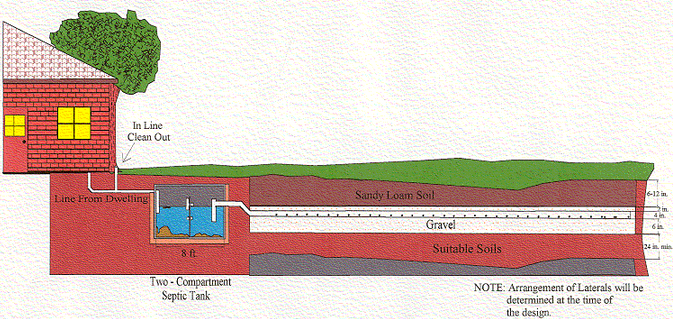
Also show all commercial wells within 125′ and public supply wells within 250′ of the proposed system. Water wells on the property and all wells within 75′ of the proposed system. Property lines, easements, road right-of-ways, regulated drains and their associated right-of-waysĦ. (especially if they are in the vicinity of the proposed system)ĥ. Proposed and existing homes, outbuildings, decks, patios and sidewalks, drive-ways, etc. Name and location of all components of the proposed septic system and their details (manufacturer and size of tanks (including effluent filter), pipe size, specifications, locations, lengths, pump model, etc.)Ĥ. A smaller scale may be used if the design is still legible.

Design drawing must be to scale (1″=20′ or 1″= 30′ preferred). Design date and revision date and descriptionĢ. Perimeter drain or interceptor requirements (if applicable)

Proposed tillage depth for mound systems (if applicable)į. Maximum and minimum trench depths (where applicable)Į. Number of bedrooms and bedroom equivalents (including residential outbuildings with plumbing)ĭ. Site address/location, owner’s name, health department project/application # (if applicable)ī. Permit card must specify the version (date) of plans approved.Ī. Permit is issued with an attached copy of the approved plans. Once approved, the plans are marked APPROVED and dated by health department.ħ. Plan review must include a site visit by the health department to evaluate the proposed system layout prior to the design approval.Ħ. Design is submitted to the health department for review.ĥ. The proposed system is marked on-site by flagging, staking or by other durable means as part of the design processĤ. Septic requirements are issued by health department.ģ. Prior to conducting the on-site evaluation, check forįlood plain or easements on the property which could affect the system location.Ģ. The health department, and designer with a laser level, are recommended to be on-site when the borings are conducted. On-site evaluation (soil borings) are conducted by a soil scientist to evaluate the site. These people may include, but are not limited to septic installers, excavators, septic designers, builders and engineers.ġ. Who can design a system? Many septic system industry persons are capable of producing the type of detailed design necessary to ensure a smooth permitting and installation process. Existing grade shot elevations at the proposed system (as needed) are essential. GIS or USGS maps or topographic surveys produced by someone else) result in unreliable data and should not be allowed. 2 ( 1/4″ in 10′) of length.Įxtrapolating system grade elevations from third party contour lines (e.g. For example, designs specify trench depths in inches and pipe grade of as little.
Septic tank drain field layout full#
Tip: All drawings, no matter how professional looking, MUST be “authenticated” by means of a full review and site visit, by the health department, prior to the permit being issued.Īccurate measurements in septic design are important, but precise vertical measurements (elevations) are vital. Plan review is the process in which these errors are discovered before they become “real world” problems. The health department’s challenge is to verify that each design is accurate on paper and in the field before the design is approved and the permit is issued. The design is the cornerstone of the septic planning process.Įrroneous designs can lead to faulty installations, violations and expensive remedies. An effective design will reflect the best choices in layout, system functionality and cost. The purpose of a septic design is to provide an accurate reference tool for use throughout the permitting and installation process. While 410 IAC 6-8.3 does not list required septic system design components, it does require “plans of sufficient clarity that it can be verified that the design of the residential on-site sewage system shall comply with the provisions of this rule.”A highly detailed septic design is necessary to fulfill this objective.
Septic tank drain field layout pdf#
PDF Version Design Requirement Recommendations DocumentĪll items referenced in this documents must be in accordance with 410 IAC 6-8.3 IEHA Waste Water Management Committee Septic System Design Requirement Recommendations Document


 0 kommentar(er)
0 kommentar(er)
